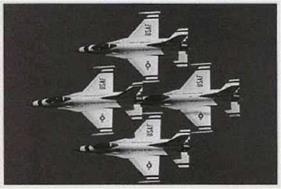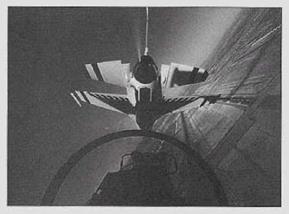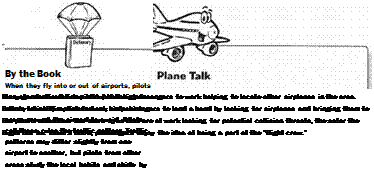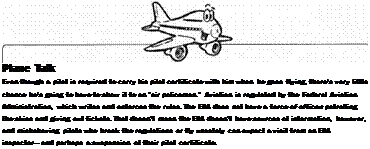Once the preflight inspection is finished, everybody settles into their seats and fastens their seat belts, something the law and common sense require.
The pilot follows the manufacturer’s checklist for starting the engine, and with a turn of a key or the push of a starter switch, the propeller starts turning, slowly at first, then at an idling speed of about 1,000 revolutions per minute.
In order to keep the plane from moving too soon, the pilot holds the brakes by pushing on the top part of the rudder pedals. Each rudder pedal controls the brake on one wheel, so pressing them both holds both wheels still. When the pilot is ready, he releases the brakes to let the plane begin to roll forward.
Taxi!
Now, airplanes trying to maneuver on the ground aren’t quite as ungraceful as a pig on roller skates, but almost. Obviously, airplanes are designed to work best in the sky. But because they have to move on the ground as well, designers have had to arrive at a compromise between flying and taxiing, as pilots call moving on the ground. (Why use the word “taxiing” when they could simply call it driving? Because, as you’ve heard me say many times already, pilots insist on being different.) Most small airplanes can be maneuvered by turning the nose wheel using the rudder pedals or by “differential braking,” which means using one brake at a time to cause the plane to swing in one direction or another.
The pilot taxis the airplane along a network of “taxiways.” To keep pilots from accidentally taxiing onto runways where they might find themselves prop-to-prop with another airplane in the middle of a takeoff or landing, taxiways are clearly marked. At airports with control towers, a controller watches taxiing airplanes like a traffic cop.
Liftoff!
The taxiing ends at a waiting area very near the beginning of the active runway. Before takeoff, pilots usually make one more safety check called a “run-up” just to make sure that it is ready to operate properly at high power.
Again, following the checklist, the pilot will check that all doors and windows are closed and secure and that his flight controls move freely. He once again checks his flight instruments to verify they are conveying the correct information, and that his fuel gauges show a safe fuel level.
Pressing the brake pedals firmly, the pilot then pushes the throttle forward until the engine is turning between 1,500 and 1,700 rpm, depending on the manufacturer’s recommendation. This allows the pilot to check the engine’s performance at a throttle setting similar to those used in flight. At this high throttle setting, flight instruments and engine instruments are put through one more check before the power is reduced to a more placid, and far quieter, 1,000 rpm or so that is generally used as an idle setting.
When the run-up is finished, the plane pulls up in line behind other airplanes waiting for takeoff, and makes a radio call to the control tower. An airtraffic controller makes sure the runway is clear of airplanes and that no other airplanes are close to landing. If all is safe, the clearance is announced over the radio: “Cleared for takeoff.”
Taxiing an airplane—moving it on the ground—can feel something like trying to pat your head and rub your stomach at the same time. That’s because most of us are used to two pedals on the floor of a car that work far differently than the pedals in an airplane. Also, it’s very tempting to grab hold of the control column and use it like a steering wheel. Actually, the control column has no effect on turning the nose wheel and turning the airplane on the ground. Our familiarity with cars works against us in the airplane.
|

ву the Book
Pilots refer to the moment of liftoff as rotation, because the elevator control causes the plane to rotate around its lateral axis. If the rotation is abrupt some airplanes can risk dragging the tail of the airplane on the ground. New airliner designs are required by the FAA to intentionally drag the tail on the runway during testing.
|
The pilot taxis onto the center line of the runway, pushes the throttle to full takeoff power, and the airplane surges ahead with a burst of acceleration. Small airplanes accelerate down the runway to speeds of 50 knots, or 58 m. p.h., or more. In the case of large jets, the wings don’t produce enough lift for flight until groundspeed reaches far more than 100 knots, or 115 m. p.h.
Between the time the pilot pushes the throttle forward for takeoff power and the time he reaches liftoff speed, which pilots call rotation speed, the pilot has to use his rudder pedals very carefully. He moves his feet down to the lower part of the pedal so he doesn’t press the brakes, which would slow his acceleration on the runway. At the very low speeds in the early moments of the takeoff the rudder won’t have much effect, but at higher speeds it does. It takes a bit of practice to steer the airplane straight during the takeoff roll.
|

Turbulence
Taxiing mistakes are one of the most common danger! at airports, including the big international jetporti and the small community ones. At the largest airports, planners are starting to experiment with city-street-style traffic controls, from lights that resemble ordinary traffic lights to devices that resemble railroad signals. There’s no consensus so far on what works best, but safe taxiing is a serious issue that lob of people are working on.
|
When the airspeed indicator on the instrument panel shows that the plane has reached a safe speed to fly, the pilot gently pulls the control column toward him, and the plane’s nose wheel lifts off the ground as the tail drops. The wings’ angle of attack widens, lift increases, and the airplane rises off its main gear into the air.
The pilot holds the nose at an upward angle that allows the plane to climb quickly and efficiently. The pilot will hold that angle, with some slight variations and maybe a brief period of level flight, depending on other air traffic around the airport, until he reaches his cruising altitude.
Cruising altitude differs depending on the type of airplane, the length of the trip, the capability of the airplane, and even which direction the flight is taking.
For small planes with relatively low power, such as training airplanes and many less expensive models, the low power production of the engine will limit the altitude a plane can climb to. That means pilots have to plan on a relatively low cruising altitude.
For very short trips, it makes no sense to fly at a high cruising altitude if the flight can be made at a lower one. After all, for a short flight, the plane might no sooner reach cruising altitude than it must begin its landing descent. In those cases, a pilot should plan as low a cruising altitude as he can.
Some airplanes cannot be flown very high because of the FAA’s oxygen requirements. Because the air is so thin above 12,500 feet above sea level, the FAA requires that pilots breathe supplemental oxygen from a special system installed in the airplane after 30 minutes of flying above that altitude. Above 14,000 feet, the pilot must breathe oxygen at all times, and above 15,000 feet, everybody on the airplane must breathe supplemental oxygen.
If the plane is not equipped with supplemental oxygen, and most small planes are not, the pilot has to plan a cruise altitude that allows him to remain below 12,500 feet most of the time. Of course, larger planes are often pressurized, meaning they are equipped with a system that keeps the air of the cabin and cockpit breathable throughout the flight, regardless of altitude. (We’ll learn more about pressurization in Chapter 19.)
Finally, the FAA dictates which altitudes a pilot can fly at, depending on the direction of flight. For example, below 29,000 feet, if a pilot is flying eastward—that is, from a

“odd thousands plus 500 feet,” meaning 3,500 feet, 5,500 feet, 7,500 feet, and so on. If he’s flying degrees—he must fly at “even thousands plus 500 feet,” or 4,500 feet, 6,500 feet, 8,500 feet, and
Above 29,000 feet, the FAA puts more altitude between planes. Heading eastward, pilots must fly at 30,000 feet, 34,000 feet, 38,000 feet, and so on in 4,000-foot increments. Heading westward the altitudes are 32,000 feet, 36,000 feet, and so on in 4,000-foot increments.
Some airplanes are like sports cars and have plenty of power to spare, allowing them to climb very quickly, maybe 1,500 feet per minute. Others are like old VW Beetles, with just enough horsepower to get the job done. These airplanes, which include some of the smaller training models, might climb at 500 feet per minute, and even less on a very hot day. (Later, we’ll discuss the effect of hot weather on an airplane’s performance.)
Either when the takeoff roll begins or when the pilot reaches a distinctive landmark near the airport, he will start a stopwatch to track flight time. As we’ve already seen, time is a crucial element in accurate dead reckoning navigation, and if a pilot forgets to click the stopwatch, he will find himself playing catchup in his navigation.
On the Radio: Working with Air Traffic Control
During flight, pilots usually have to talk on the two-way radio with air-traffic controllers. For some reason, the idea of talking on the radio causes some pilots a lot of anxiety. Practice and experience usually calm their nerves.
Contrary to common opinion, by the time pilots have filled some pages of their logbooks with flying time, most understand that air-traffic controllers occupy a relatively small, albeit important, role in a typical flight. And with a little familiarity with the language pilots use to express themselves clearly, the give-and-take between pilot and controller becomes easy and friendly.
|

On Course
|
I’ve spent a great deal of time flying from high-altitude airports and experienced some nervous moments. Because the atmosphere gets thinner at higher altitudes, airplanes at high-altitude airports are slower to accelerate during takeoff and require longer runways. Once in the air, airplanes climb more slowly than they do at a sea-level airport.
$bll, some of the most beautiful airports in the world ate at high altitudes, and pilots seldom regret the extra training and pracbce they need to fly out of them.
The typical radio call follows a basic pattern: Who is calling, where they are, and what they want to do. For example, here’s what a pilot’s radio call might sound like shortly after takeoff from Worcester airport in central Massachusetts for a flight to Portland, Maine:
“Boston Center, Cessna four-five-zero-one-Charlie, over Worcester at five thousand five hundred feet en route to Portland, request flight following.”
In a few words, the pilot, using the registration number of his airplane, Cessna 4501C, told a controller overseeing Boston-area air traffic that he was over the city of Worcester, he was flying at 5,500 feet above sea level, that his destination was Portland, and that he would like controllers to follow him on radar to his destination.
For some flights in good weather, controllers don’t have to agree to the flight-following service. It depends on their workload. But if she can manage it, the controller will agree to act as a sort of second set of eyes for the pilot.
If the controller does agree to follow the flight, the pilot will be assigned a distinctive “squawk,” or transponder code. A transponder is an on-board avionics device that amplifies the reflection of radar waves from an airplane. It makes the dot representing an airplane appear larger and brighter on a controller’s radar screen.
The individual code also helps controllers distinguish airplanes from one another, which is particularly helpful in crowded airspace. The controller’s radar screen automatically calculates the plane’s groundspeed, which pilots can ask for to see how accurately they predicted their speed. What’s more, some transponders tell controllers what altitude the plane is flying at, which helps controllers keep pilots away from other airplanes.
|

Plane Talk
Transponders. which were first used in World War II to help radar operators recognize friendly planes so they wouldn’t shoot down an ally, have now been adapted to another life-saving duty. Some very new transponders are able to detect nearby airplanes, something older versions couldn’t do. If that’s not enough, the new transponders use a synthesized human voice to warn the pilot of an impending collision with a suggestion which direction to turn to avoid it. There have been some bugs in the system, but the new class of transponders promise to help make flying even safer.
|














































